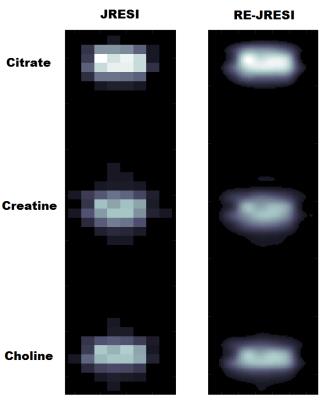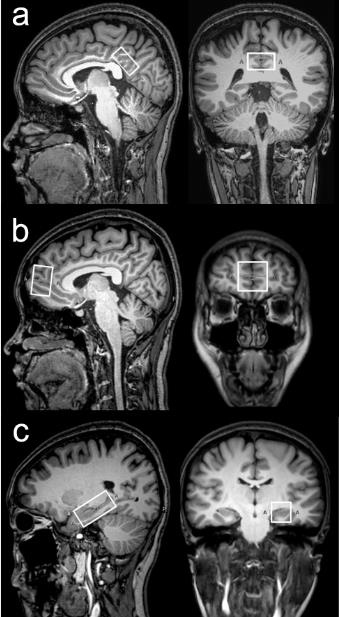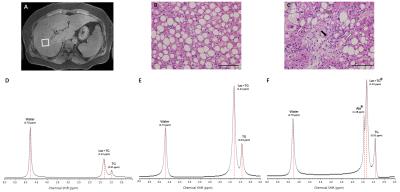Poster: MRS/MRSI Applications
Electronic Power Pitch Poster
MR Spectroscopy
Wednesday, 26 April 2017
| Exhibition Hall |
17:15 - 18:15 |
| |
|
Plasma # |
 |
0877.
 |
16 |
Resolution Enhanced accelerated Four Dimensional Echo Planar Spectroscopic Imaging: Application in Prostate Cancer 
Zohaib Iqbal, Brian Burns, Rajakumar Nagarajan, Robert Reiter, Steven Raman, M. Albert Thomas
Prostate cancer (PCa) remains the most prevalent form of cancer in men. For diagnosis, Prostate-Specific Antigen (PSA) levels are most commonly used as a screening tool. Chemical shift imaging (CSI) methods can provide information on the biochemical concentrations of metabolites in different regions of the prostate. Here, we demonstrate a novel technique capable of improving the spatial and spectral resolution of the accelerated echo-planar J-resolved spectroscopic imaging (EP-JRESI) method, which obtains 2 spatial and 2 spectral dimensions in a single scan. This resolution enhanced EP-JRESI (RE-JRESI) method is evaluated in PCa patients and compared to the EP-JRESI results.
|
|
0878.
 |
17 |
Initial results of combined 1H and 31P spectroscopic imaging of the prostate at 7 Tesla 
Bart Philips, Mark van Uden, Tom Scheenen
Proton MR spectroscopy has proven to be a valuable tool in the evaluation and detection of prostate cancer by assessing metabolite ratios incorporating choline and citrate signals. The choline peak in the proton spectrum actually consists of several different peaks of choline containing compounds[2], of which some can be distinguished using 7 Tesla 31P spectroscopic imaging. In this work we present our first patient results of a method that combines 31P and 1H within one measurement using a 31P Tx/Rx and 1H Rx endorectal coil and we show its feasibility for correlating 31P and 1H metabolite ratios.
|
|
0879.
 |
18 |
Reduced GABA levels correlate with cognitive impairment in relapsing-remitting multiple sclerosis 
Guanmei Cao, Bin Zhao, Guangbin Wang, Weibo Chen, Fei Gao
To investigate whether cognitive impairment in relapsing-remitting multiple sclerosis (RRMS) is associated with alterations in brain gamma-aminobutyric acid (GABA) levels, 31 RRMS patients and 26 healthy controls underwent 3T 1H MRS and neuropsychologic assessment. GABA levels were quantified in the posterior cingulate cortex (PCC), the medial prefrontal cortex (mPFC) and left hippocampus (LHC). Patients showed reduced GABA+ in PCC and LHC, and reduced GABA+ levels correlated with cognitive function. This study demonstrates that abnormalities of the GABAergic system may be an important neurochemical mechanism of cognitive impairment in RRMS.
|
 |
0880.
 |
19 |
Patch-based super-resolution of MRSI data in multiple sclerosis patients at 7 T 
Saurabh Jain, Gilbert Hangel, Diana Sima, Wolfgang Bogner, Siegfried Trattnig, Sabine Van Huffel, Frederik Maes, Dirk Smeets
The clinical application of brain MRSI is, upon several factors, limited by the comparatively low resolution that makes it difficult to resolve lesions. This work demonstrates the application of a patch-based super-resolution (PBSR) method that increases the spatial resolution of metabolite maps obtained from MRSI. The method is validated against conventional interpolation techniques in multiple sclerosis patient measurements. Our results clearly show the benefits of PBSR over other common interpolation techniques.
|
 |
0881.
 |
20 |
Cervical spinal cord and brain MRS alterations in normal appearing white matter of multiple sclerosis (MS) patients at 3T 
Patrik Wyss, Anke Henning, Andreas Hock, Andreas Lutterotti, Roland Martin, Spyros Kollias
This investigation explores alterations of both cervical spinal cord and brain metabolite levels in normal appearing tissue in patients suffering from multiple sclerosis (MS). In the brain, a 2 dimensional J-resolved spectroscopy sequence and 2D prior-knowledge fitting is used and the metabolite cycling technique is applied to the cervical spinal cord at 3T. Relapsing-remitting MS (RRMS) and secondary progressive MS (SPMS) patients are included and alterations between brain and spinal cord metabolites are addressed.
|
|
0882.
 |
21 |
1H-NMR of carnosine combined with 31P-NMRS to better characterize skeletal muscle pH dysregulation in Duchenne muscular dystrophy 
Harmen Reyngoudt, Suna Turk, Pierre G. Carlier
The finding of an alkaline Pi pool has been established with 31P-NMRS in healthy resting skeletal muscle and the dystrophic muscle of GMRD dogs and DMD patients. The pH values corresponding to this Pi pool corresponds better with extracellular pH. Intracellular pH, however, can also be measured with 1H-NMRS, using carnosine. In a group of DMD patients, we observed that pH determined with 31P-NMRS were systematically increased, whereas this was not always the case for pH based on the measurement of carnosine, revealing two groups in dystrophic muscle: (1) pH elevated with 31P and 1H and (2) pH only elevated with 31P.
|
|
0883.
 |
22 |
Apparent short transverse relaxation time of inorganic phosphate in breast cancer tissue at 7 tesla. 
Wybe van der Kemp, Tijl van der Velden, Alexander Schmitz, Kenneth Gilhuijs, Peter Luijten, Dennis Klomp, Jannie Wijnen
Here we show in a patient group with breast cancer an apparent shortening of the transverse relaxation time of the Pi signal at 7 tesla, as compared to healthy breast fibroglandular tissue and propose an underlying mechanism to explain this observation.
|
|
0884.
 |
23 |
Acetate metabolism towards fatty acids is down-regulated in IDH1 mutant glioma as shown by 13C MRS 
Chloé Najac, Marina Radoul, Pavithra Viswanath, Myriam Chaumeil, Sabrina Ronen
IDH1 is the most prevalent driver mutation in lower-grade glioma and upgraded glioblastoma and is associated with additional metabolic reprogramming. Here, we investigated fatty acid biosynthesis and the role of acetate, which was recently recognized as a major fuel in primary glioblastoma. Labeling cells harboring either wild-type or mutant IDH1 with [1,2-13C]-acetate, we found a decrease in flux towards fatty acids in mutant IDH1 cells although the total fatty acid pools remained unchanged. Associated with cell biological assays, these results point to alternate sources for maintenance of fatty acid levels in IDH1 mutant cells.
|
 |
0885.
 |
24 |
Automatic tissue-type classification of 1H-MRSI spectra in patients with glioblastoma 
Nuno Pedrosa de Barros, Raphael Meier, Martin Pletscher, Urspeter Knecht, Mauricio Reyes, Roland Wiest, Johannes Slotboom
Clinical-routine MRSI-data analysis is commonly performed through the visual inspection of multiple metabolite and metabolite-ratio maps, and aims at translating the different spectroscopic patterns into known tissue-types, such as, necrosis, solid tumour, tumour-infiltration, normal-brain-tissue, etc. Such translation/segmentation requires solid expertise in MR-spectroscopy, which most clinicians do not have. Bad-quality-data, as well as frequency-dependant-selection-profiles further complicate proper interpretation of MRSI-data. Therefore, to facilitate the clinical-use of MRSI, we present an automatic MRSI-tissue-type segmentation algorithm, that includes automatic-quality-filtering and selection-profile-correction. The method was tested in glioblastoma and the tissue-types were compared against an MRI-based tumour-segmentation-method.
|
|
0886.
 |
25 |
High and Ultra-High Field Proton MR Spectroscopy in Early Amyotrophic Lateral Sclerosis 
Ian Cheong, Malgorzata Marjanska, Dinesh Deelchand, Lynn Eberly, David Walk, Gulin Oz
Amyotrophic lateral sclerosis (ALS) is a devastating disease of motor neurons with unknown etiology. Evidence suggests that the brain undergoes degenerative changes in ALS, particularly within areas of the descending motor pathway. Identifying robust and non-invasive biomarkers that are sensitive to neurodegeneration in ALS is essential for improving clinical trial design and assessment of treatment effectiveness. This study evaluated 1H-MRS-measured metabolite levels as biomarkers of disease severity. Ultra-high field (7 tesla) 1H-MRS revealed metabolic abnormalities in the motor cortex and brainstem of humans with ALS that are dependent on disease stage.
|
|
0887.
 |
26 |
Detection of in vivo biomarkers in fungal brain infection models and potential determination of cell viability. 
Liesbeth Vanherp, Amy Hillen, Jennifer Poelmans, Katrien Lagrou, Greetje Vande Velde, Uwe Himmelreich
Animal models of cerebral infection by the pathogenic fungi Cryptococcus neoformans and C. gattii were developed and assessed longitudinally by using anatomical and diffusion MRI as well as MR spectroscopy. MR spectroscopy identified in vivo biomarkers for potential etiological diagnosis and more importantly for quantification of the fungal load in living animals. Our results have great potential to assist in the differential diagnosis of brain lesions in patients, whereby MR spectroscopy is a safer, non-invasive and rapid method in comparison to traditional invasive diagnostic methods such as CSF sampling or biopsies.
|
|
0888.
 |
27 |
Metabolic variability in a brief status epilepticus model 
Jullie Pan, Yijen Wu, Patrice Pearce, Nihal de Lanerolle, Kevin Kelly
This study uses short echo MR spectroscopy (TE 10ms) to study the metabolic changes seen in a status epilepticus kainate rodent model. Applied with a brief period (45min) of seizures, a hierarchical cluster analysis is performed on the spectroscopic changes measured 3days after the status injury. These data displayed a bimodal distribution characterizing two groups of animals, “more” or “less” injured. The classification persists into a repeat MRS measurement performed at 3wk, with the less injured group being able to recover; the more injured group did not recover well. Finally, this classification was consistent with Nissl based histological analysis.
|
 |
0889.
 |
28 |
Polyunsaturated fatty acid (PUFA) is associated with tumour grading – An ex vivo study on whole breast tumours using multiple quantum coherence (MQC) MRS 
Sai Man Cheung, Ehab Husain, Yazan Masannat, Klaus Wahle, Steven Heys, Jiabao He
Eicosanoids are derivatives of three different PUFA, vital in membrane formation and anti-inflammatory control. The presence of eicosanoids in adipose tissue and fibroblasts governs the release of signalling agents in breast, stimulating the invasion of breast cancer cells. Lipid composition has emerged as a potential predictor of breast cancer. However, current research focuses on the tumour initiation, while the understanding of lipid function in tumour progression remains sparse. We therefore hypothesise that there is a difference in PUFA concentration between grade II and III breast cancer. We applied MQC MRS for accurate PUFA measurement on freshly excised whole breast tumours.
|
 |
0890.
 |
29 |
In-Vivo Regional detection of Gly in Human Brain: Implications in Glioma Patients at 3T - permission withheld
Vivek Tiwari, Zhongxu An, Sandeep Ganji, Changho Choi
Glycine, an inhibitory-neurotransmitter and a co-agonist of N-Methyl-D-aspartate, has been implicated in rapid cancer cell-proliferation and is elevated in high-grade gliomas than low-grade. Gly concentrations range from 0.5-1.0 M in normal brain and exhibits regional-variation. Given such a low in-vivo concentration of Gly, potential overlap from mI and regional-variation, here we have developed a novel Gly-optimized single-voxel-localized triple-refocusing scheme for precise co-detection of Gly and mI in Gray-matter (GM)-rich Medial-Occipital (MO) and White-matter (WM) rich Left-Parietal (LP) healthy-brain region, and further extended to measure glycine level in glioma patients.
|
|
0891.
 |
30 |
Differential diagnosis of Hepatic metabolites between non-alcoholic steatohepatitis and simple steatosis in humans and a murine model using a 1H MR spectroscopy study with long TE - permission withheld
Tae-Hoon Kim, Hong Young Jun, Chang-Won Jeong, Jong-Hyun Ryu, Kou Gyeom Kim, Kwon-Ha Yoon
Liver biopsy is the gold standard for diagnosing non-alcoholic fatty liver disease(NAFLD) but with practical constraints. MR spectroscopy(MRS) allows in vivo assessment of hepatocellular metabolism and has shown potential for biochemical differentiation in diffuse liver disease. Recent 13C-MRS demonstrated that alanine and lactate levels in inflammatory liver injury were increased compared to those in normal liver, and these changes were positively correlated with liver enzyme levels. However, the clinical use of 13C-MRS technique is limited because it necessitates 13C-resonance specific hardwares and softwares for data acquisition. This study used long TE 1H-MRS to monitor changes of hepatocellular metabolites in NAFLD.
|
|
 Power Pitches Video
Power Pitches Video














